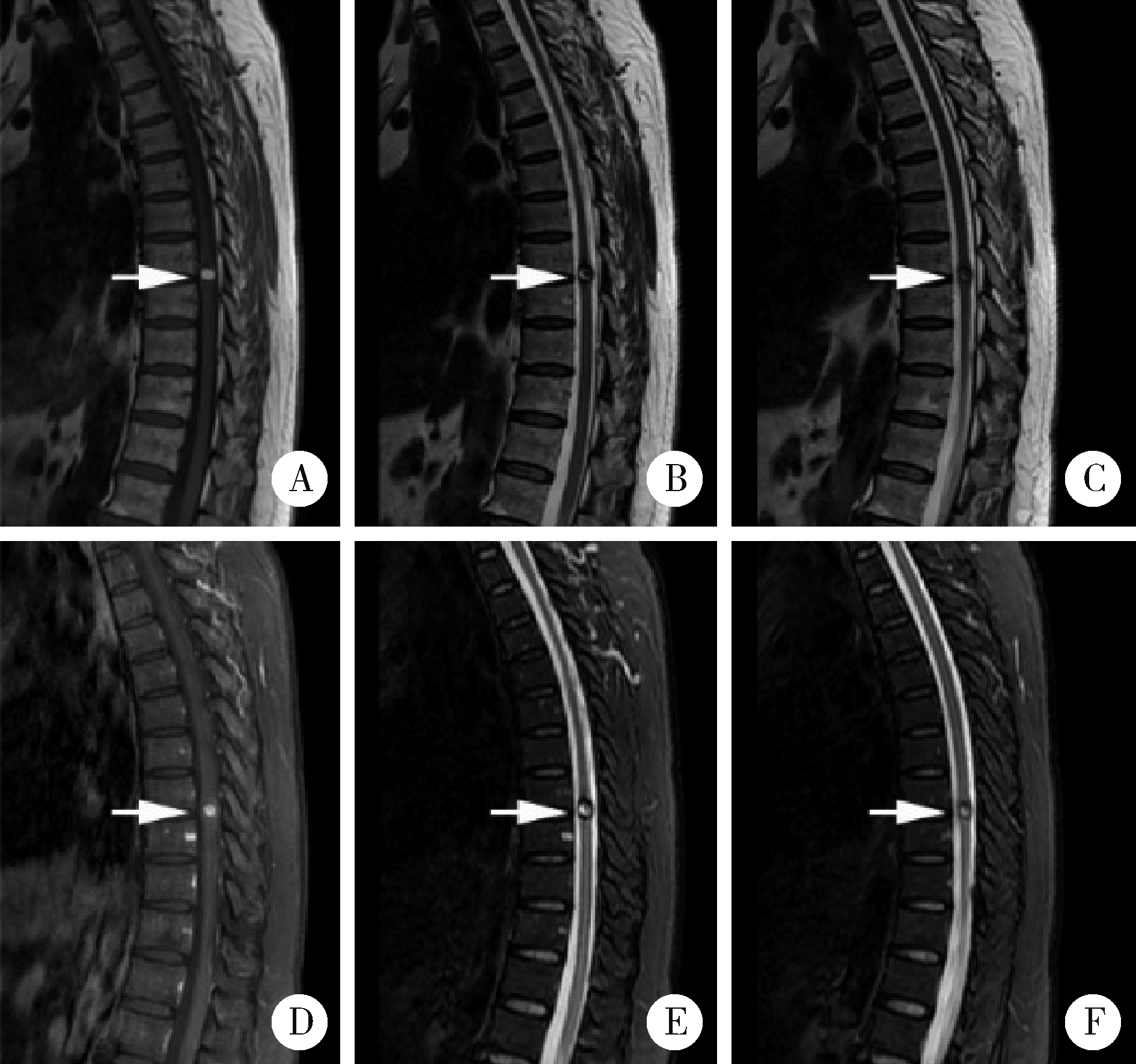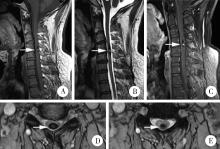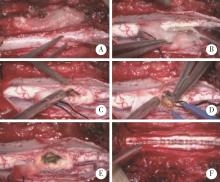Journal of Peking University (Health Sciences) ›› 2023, Vol. 55 ›› Issue (4): 652-657. doi: 10.19723/j.issn.1671-167X.2023.04.014
Previous Articles Next Articles
Prognosis of patients with spinal intramedullary cavernous hemangioma by different treatments
Bin CHEN,Chao WU,Bin LIU,Tao YU,Zhen-yu WANG*( )
)
- Department of Neurosurgery, Peking University Third Hospital, Beijing 100191, China
CLC Number:
- R651.2
| 1 |
ZevgaridisD,MedeleR J,HamburgerC,et al.Cavernous haemangiomas of the spinal cord. A review of 117 cases[J].Acta Neurochir,1999,141(3):237-245.
doi: 10.1007/s007010050293 |
| 2 |
BadhiwalaJH,FarrokhyarF,AlhazzaniW,et al.Surgical outcomes and natural history of intramedullary spinal cord cavernous malformations: A single-center series and meta-analysis of indivi-dual patient data: Clinic article[J].J Neurosurg Spine,2014,21(4):662-676.
doi: 10.3171/2014.6.SPINE13949 |
| 3 |
DalitzK,VitzthumHE.Evaluation of five scoring systems for cervical spondylogenic myelopathy[J].Spine J,2019,19(2):e41-e46.
doi: 10.1016/j.spinee.2008.05.005 |
| 4 |
SchermanDB,RaoPJ,VarikattW,et al.Clinical presentation and surgical outcomes of an intramedullary C2 spinal cord cavernoma: A case report and review of the relevant literature[J].J Spine Surg,2016,2(2):139-142.
doi: 10.21037/jss.2016.04.01 |
| 5 |
PétillonP,WilmsG,RaftopoulosC,et al.Spinal intradural extramedullary cavernous hemangioma[J].Neuroradiology,2018,60(10):1085-1087.
doi: 10.1007/s00234-018-2073-6 |
| 6 |
NieQB,ChenZ,JianFZ,et al.Cavernous angioma of the cauda equina: A case report and systematic review of the literature[J].J Int Med Res,2012,40(5):2001-2008.
doi: 10.1177/030006051204000542 |
| 7 |
LiangJT,BaoYH,ZhangHQ,et al.Management and prognosis of symptomatic patients with intramedullary spinal cord cavernoma: Clinical article[J].J Neurosurg Spine,2011,15(4):447-456.
doi: 10.3171/2011.5.SPINE10735 |
| 8 |
ArdeshiriA,ÖzkanN,ChenB,et al.A retrospective and consecutive analysis of the epidemiology and management of spinal cavernomas over the last 20 years in a single center[J].Neurosurg Rev,2016,39(2):269-276.
doi: 10.1007/s10143-015-0674-7 |
| 9 | BaldvinsdóttirB,ErlingsdóttirG,Kjartanssonó,et al.Extrame-dullar cavernous hemangioma with intra- and extradural growth and clinical symptoms of Brown-Séquard syndrome: Case report and review of the literature[J].World Neurosurg,2016,98(11):881. e5-881. e8. |
| 10 | OttenM,McCormickP.Natural history of spinal cavernous malformations[J].Handb Clin Neurol,2017,143,233-239. |
| 11 | MithaAP,TurnerJD,SpetzlerRF.Surgical approaches to intramedullary cavernous malformations of the spinal cord[J].Neurosurgery,2011,68(2):317-324. |
| 12 |
ZhangL,YangW,JiaW,et al.Comparison of outcome between surgical and conservative management of symptomatic spinal cord cavernous malformations[J].Neurosurgery,2016,78(4):552-561.
doi: 10.1227/NEU.0000000000001075 |
| 13 |
ReitzM,BurkhardtT,VettorazziE,et al.Intramedullary spinal cavernoma: Clinical presentation, microsurgical approach, and long-term outcome in a cohort of 48 patients[J].Neurosurg Focus,2015,39(2):E19.
doi: 10.3171/2015.5.FOCUS15153 |
| 14 |
AoyamaT,HidaK,HoukinK.Intramedullary cavernous angiomas of the spinal cord: Clinical characteristics of 13 lesions[J].Neurol Med Chir (Tokyo),2011,51(8):561-566.
doi: 10.2176/nmc.51.561 |
| 15 | 李熊辉,王振宇,刘彬.脊髓髓内海绵状血管瘤的诊疗现状[J].中国脊柱脊髓杂志,2017,27(3):276-279. |
| 16 |
AzadTD,VeeravaguA,LiA,et al.Long-term effectiveness of gross-total resection for symptomatic spinal cord cavernous malformations[J].Neurosurgery,2018,83(6):1201-1208.
doi: 10.1093/neuros/nyx610 |
| 17 | 董伟杰,刘馨蔓,苏月焦,等.脊髓髓内海绵状血管瘤的显微手术治疗[J].中华显微外科杂志,2018,41(2):105-108. |
| [1] | Ying ZHOU,Ning ZHAO,Hongyuan HUANG,Qingxiang LI,Chuanbin GUO,Yuxing GUO. Application of double-layer soft tissue suture closure technique in the surgical treatment of patients with mandible medication-related osteonecrosis of the jaw of early and medium stages [J]. Journal of Peking University (Health Sciences), 2024, 56(1): 51-56. |
| [2] | HONG Peng,TIAN Xiao-jun,ZHAO Xiao-yu,YANG Fei-long,LIU Zhuo,LU Min,ZHAO Lei,MA Lu-lin. Bilateral papillary renal cell carcinoma following kidney transplantation: A case report [J]. Journal of Peking University (Health Sciences), 2021, 53(4): 811-813. |
| [3] | Jie YANG,Ran ZHANG,Yu-nan LIU,Dian-can WANG. Plunging ranula presenting as a giant retroauricular mass: A case report [J]. Journal of Peking University(Health Sciences), 2020, 52(1): 193-195. |
| [4] | Rong YANG,Qing-xiang LI,Chi MAO,Xin PENG,Yang WANG,Yu-xing GUO,Chuan-bin GUO. Multimodal image fusion technology for diagnosis and treatment of the skull base-infratemporal tumors [J]. Journal of Peking University(Health Sciences), 2019, 51(1): 53-58. |
|
||









